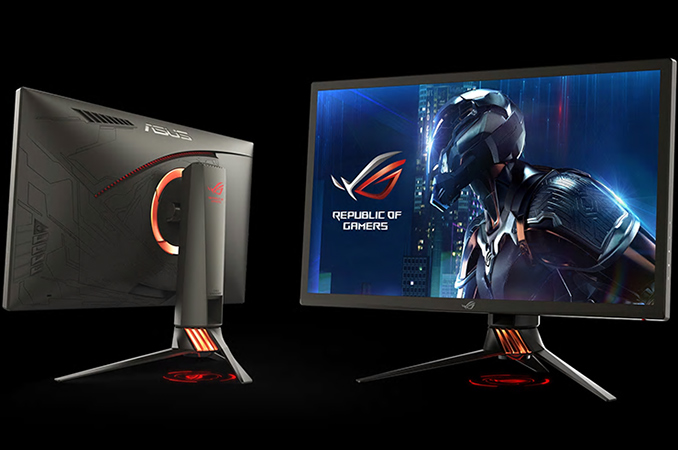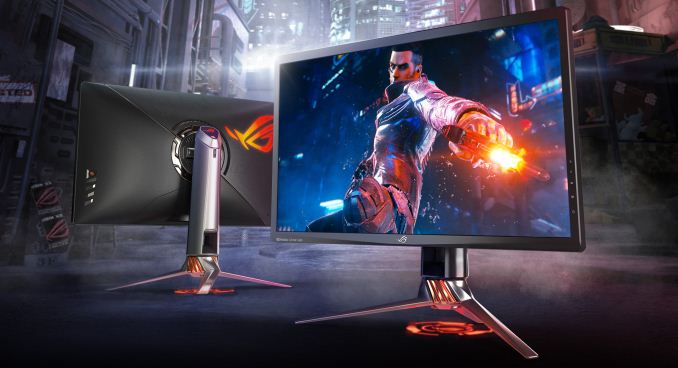ASUS’ ROG Swift PG27UQ G-Sync HDR Display Due in Late June For $1999
by Anton Shilov on May 24, 2018 1:00 PM EST- Posted in
- Monitors
- Asus
- 4K
- 144Hz
- Quantum Dot
- ROG Swift PG27UQ
- G-Sync HDR

ASUS this week announced the final specs, official price, and launch timeframe for its highly-anticipated ROG Swift PG27UQ monitor that supports NVIDIA’s G-Sync HDR technology and features a 4K Ultra HD resolution as well as a 144 Hz maximum refresh rate. The display will hit the market in late June and will cost nearly $2000.
As reported, both the ASUS ROG Swift PG27UQ and the Acer Predator X27 displays are use the same principle components as NVIDIA’s reference design for G-Sync HDR monitors and therefore offer very similar general specs (keep in mind that they are not the same monitors and the differences are noteworthy). Acer intends to ship its top-of-the-range Predator monitor on June 1 and Newegg is already taking pre-orders on the product. The ASUS display will ship a bit later, so it cannot be pre-ordered right now.
As readers interested in the NVIDIA G-Sync HDR technology already know, the ROG Swift PG27UQ is based on AU Optronics’ 10-bit AHVA panel featuring a 3840×2160 resolution, a 1000:1 contrast ratio, 178°/178° horizontal/vertical viewing angles, a 4 ms response time, an "up to" 144 Hz refresh rate (native refresh rate is 120 Hz), and a 1000 nits peak luminance. One of the most important features of the monitor is its 384-zone FALD backlight to offer the necessary localized contrast ratios, which is enhanced with quantum dots to ensure the DCI-P3 color gamut. Meanwhile ASUS emphasizes that its PG27UQ monitor will ship calibrated to Delta E<3 accuracy and can display 99% of the AdobeRGB and 97% of the DCI-P3 color ranges. The display is VESA DisplayHDR 1000-certified and UltraHD Premium branding is pending.
One of the interesting features that the ROG Swift PG27UQ supports is ambient light sensor that is used to adjust brightiness depending on ambient light conditions.
When it comes to connectivity, the PG27UQ has a DisplayPort 1.4 input (which is required to display 4K content with a 144 Hz refresh rate and 4:2:2 chroma subsampling) as well as an HDMI 2.0 header (that can handle 4Kp60). In addition, the monitor has a dual-port USB 3.0 hub as well as a 3.5-mm audio jack.
Since we are dealing with an ASUS ROG monitor, it supports various gaming specific display modes tailored for various genres. In addition, like all modern gaming LCDs, the PG27UQ comes with programmable LED RGB lighting. In particular, it supports the ASUS Aura Sync technology, two projectors (one projects lighting effects onto a desktop surface, another projects them onto a wall) and one LED zone on the back.
ASUS currently intends to ship its top-of-the-range gaming monitor in late June at an MSRP of $1999.
| Specifications of ASUS ROG Swift PG27UQ Gaming Monitor | |||
| PG27UQ | |||
| Panel | 27" IPS (AHVA) | ||
| Resolution | 3840 × 2160 | ||
| Refresh Rate | Native: 120 Hz 4:4:4 HDR: 98Hz 4:2:2 HDR: 120Hz Overclocked 4:2:2 HDR: 144 Hz |
||
| Variable Refresh Rate | NVIDIA G-Sync HDR | ||
| Response Time | 4 ms | ||
| Brightness | Native: 300 - 600 cd/m² Peak: 1000 cd/m² |
||
| Contrast | 1000:1 | ||
| Backlighting | FALD, 384 zones | ||
| Quantum Dot | Yes | ||
| HDR | HDR10 Support | ||
| Viewing Angles | 178°/178° horizontal/vertical | ||
| PPI | 163 pixels per inch | ||
| Colors | 1.07 billion | ||
| Color Saturation | sRGB: 100% Adobe RGB: 99% DCI-P3: 90 Rec. 2020: ? |
||
| Inputs | 1 × DisplayPort 1.4 1 × HDMI 2.0 |
||
| Audio | 3.5-mm audio jack | ||
| USB Hub | 2-port USB 3.0 | ||
| Stand Adjustments | Tilt: +20°~-5° Swivel: +160°~+160° Pivot: +90°~-90° Height Adjustment: 0~120 mm |
||
| Vesa Mount | 100 × 100 | ||
| Power Consumption | Idle: ? Peak: 180 W with HDR on |
||
Related Reading:
- Acer’s Predator X27 G-Sync HDR Display Listed in the USA, to Ship on June 1
- NVIDIA Updates on G-Sync HDR: 4Kp144 Monitors On Sale at End of May, Other Models Coming Later This Year
- Acer and ASUS G-Sync HDR Displays Listed & Priced In Europe
- NVIDIA Expects 4K 144 Hz G-Sync HDR Displays to Launch in April
- Acer and ASUS Delay Their 4K 144 Hz G-Sync HDR Displays to 2018
- ASUS Demonstrates ROG Swift PG27UQ: 4K, 144 Hz, HDR, DCI-P3 and G-Sync
- Acer Announces Predator X27 Monitor: 4K@144 Hz with DCI-P3, HDR10, & G-Sync
- Samsung Announces First Freesync 2 Monitors: CHG70 & CHG90 - Quantum Dots, Up to 49”, 144 Hz, DCI-P3











33 Comments
View All Comments
Makaveli - Thursday, May 24, 2018 - link
Looks nice but 27' is too small for 4k and that 2k price tag no thanks.a5cent - Thursday, May 24, 2018 - link
Theoretically, a high DPI display should have no impact on the size of UI elements (icons, text etc), It should affect only clarity/sharpness. Software based on the universal windows platform (UWP) does this perfectly without requiring any specific developer effort. It's 2018 and it's a shame software developers still can't update their older Win32 UIs and make them high-DPI aware.Unfortunately this is a chicken/egg problem. Until more high-DPI displays make it into people's hands and complain, developers won't update their software, but until developers do, people won't buy high-DPI displays 😕 I wonder how long we'll be stuck in 1995 in terms of PPI.
rpg1966 - Thursday, May 24, 2018 - link
4K looks awesome on even a 15.6" laptop display, so even though you sit slightly further back from a 27" screen it still looks great.eva02langley - Thursday, May 24, 2018 - link
The G-synch tax is strong with this one. 4k even at 120Hz, doesn't worth that much. There is more interesting TVs on the market that could be used instead.jordanclock - Thursday, May 24, 2018 - link
I'm not aware of any other 4K 144Hz (regardless of adaptive refresh rate technology) monitor that is even available, so I'm not sure how you can claim this price is due to G-Sync, let alone whether it is a worthy price.AsParallel - Thursday, May 24, 2018 - link
LG released one earlier this week. Same price. Maybe 1 centabo cheaper.Some of it is due to gsync. Adds roughly 200 to the price, hence the lack of adoption. Bright side is, it actually works as opposed to freesync.
jordanclock - Thursday, May 24, 2018 - link
What model is that? I can't seem to find any announcements or listings for that.jordanclock - Thursday, May 24, 2018 - link
Oh wait, I think I found it, the 32UD99-W. 4K, 144Hz with FreeSync, HDR10. MSRP $1000.So the upgraded G-Sync module for 4K support seems to be considerably more than $200 OR they've increased the mark up considerably.
The only numbers I can't find to compare at the moment is the chroma subsampling options for the LG at 144Hz.
a5cent - Thursday, May 24, 2018 - link
No, AsParalell is right, it's not the g-sync module, nor is it the markup. It's the FALD backlight and the engineering efforts that go with it. You can't get 1000 nits at the center of the screen and simultaneouly 0.1 nits at the corners without FALD. You can also expect to see very little backlight bleed (if any at all). At least that is the promise. If it holds up in tests, you will be getting a professional grade display (which are no less expensive) from a gaming monitor.FullmetalTitan - Thursday, May 24, 2018 - link
This monitor (and the Acer one) have basically every professional feature out there PLUS 144Hz refresh. The comparable professional displays all cost about this much, but lack the high refresh, G-sync, additional connectivity in many cases, and the ones with FALD have 1/2 or 1/4 the discrete backlighting zones.